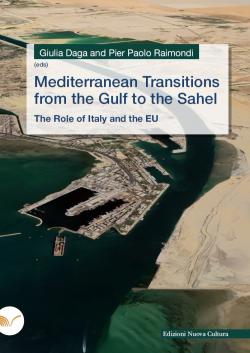Mediterranean Transitions from the Gulf to the Sahel. The Role of Italy and the EU
La guerra a Gaza e quella in Ucraina, la crisi energetica e diverse iniziative per ridefinire i partenariati e le alleanze regionali e internazionali hanno reso il vicinato meridionale dell’UE sempre più strategico per gli interessi italiani ed europei. L’urgenza di diversificare l’approvvigionamento energetico (attingendo sia ai combustibili fossili sia alle fonti di energia pulita) ha spinto l’Italia a rafforzare i partenariati già esistenti con i paesi della sponda meridionale del Mediterraneo, nonché a crearne di nuovi e a rivolgersi anche ai paesi dell’Africa subsahariana. Ciò allo scopo di trasformare l’Italia in un hub energetico e di renderla autonoma dalla Russia. Per riflettere su come diversificare l’approvvigionamento energetico e sulle riconfigurazioni politiche è necessario considerare due regioni altamente strategiche, il Mar Rosso e il Golfo.Queste due regioni sono sempre più interconnesse con il vicinato meridionale dell’UE sia in termini politici che economici, come riconosce anche la recente strategia energetica europea. Questo volume si concentra sui più recenti riallineamenti energetici e politici che coinvolgono gli attori dell’area, cercando di individuare delle linee guida per un approccio integrato in grado di rispondere alle priorità della politica estera italiana e di quella europea.
Volume prodotto nell’ambito del progetto “Transizioni mediterranee: rischi e opportunità per la politica energetica, estera e di sicurezza italiana ed europea nel Vicinato meridionale”.
-
Dati bibliografici
Roma, Nuova Cultura, settembre 2024, 139 p. -
Numero
11 -
ISBN/ISSN/DOI:
978-88-3365-701-1 ; 10.4458/7011
Contributors, p. 7-8
List of abbreviations, p. 9-10
Introduction, by Giulia Daga and Pier Paolo Raimondi, p. 11-14
1. EU-African Energy and Climate Cooperation in Light of Reconfiguration of Energy Flows, by Pier Paolo Raimondi, p. 15-36
1.1 Current EU-Africa energy trade and perspectives for higher contribution
1.2 Potential future contribution – critical raw materials and hydrogen
1.3 Domestic energy needs
1.4 Different challenges to EU-Africa cooperation
1.5 The Italian Mattei Plan: A positive initial step
2. Regional Energy Cooperation in the Gulf: What Role for Europe?, by Mehran Haghirian, p. 37-57
2.1 European energy interests in the Gulf
2.2 Oil
2.3 Gas
2.5 Power generation and electricity
2.6 Solar and wind
2.7 Water
2.8 Minerals
2.9 Nuclear energy
2.10 Conclusion
3. Regional Reconfigurations and Geopolitical Shifts in the Sahel and Mediterranean, by Darlington Tshuma, p. 59-80
3.1 Impact of fragility on security, governance and democracy in the Sahel
3.2 The Sahel’s triple challenge: Integrating humanitarian, development and security agendas
3.3 Dynamics of fragility and insecurity in the Sahel
3.4 Geopolitical competition and posturing in the Sahel
3.5 Regime reconfiguration and geopolitical pivoting and its impact on security in the Sahel
3.6 Russia’s military-economic footprint in the Sahel: Implications for European policy
3.7 Opportunities and challenges for Italian foreign policy in the Sahel and Mediterranean regions
3.8 Conclusion
4. Constructive Diplomatic Shifts in the Geopolitical Landscape of the Gulf, by Mehran Haghirian, p. 81-102
4.1 Era of maximum regional tensions in the Gulf
4.2 Restoring diplomatic ties in the Gulf
4.3 Challenges facing the durability of diplomatic engagements in the Gulf
4.4 Europe’s role in supporting regional diplomacy in the Gulf
5. Global Powers and the Wars of Narratives: China, Russia and the US Navigating Transitions in the Middle East and Africa, by Giulia Daga, p. 103-132
5.1 The People’s Republic of China
5.2 The Russian Federation
5.3 The United States of America
5.4 Implications for Europe
6. Conclusions: Italy in a Shifting Global Order, by Maria Luisa Fantappiè, p. 133-139




